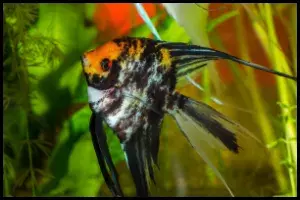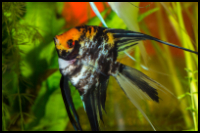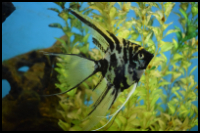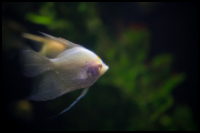





Quick Care Details (Table)
| Livestock Characteristics | Value |
|---|---|
| Care Level | Easy |
| Temperament | Semi-Aggressive |
| Diet | Omnivore |
| Maximum Size | 8 Inches |
| Minimum Tank Size | 20 Gallons |
| Plant Safe | Yes |
| Temperature Range | 78-82F |
| PH Range | 6.5-7.5 |
| KH Range | 3-8 dKH |
| GH Range | 4-10 dGH |
Species Specific Categories
Helpful Video
Care Details
Aquascape
- Create a well-planted aquarium with a variety of live plants to mimic their natural habitat.
- Use driftwood, rocks, and other decorations to create hiding spots and territories for the freshwater angelfish.
- Consider adding floating plants to provide shade and reduce the intensity of lighting.
Substrate
- Choose a substrate that is suitable for planted aquariums, such as aquarium soil or fine-grained gravel.
- Avoid sharp or rough substrates that may damage the angelfish's delicate fins.
- Adequate substrate depth (2-3 inches) allows plants to establish a root system.
Disease prevention
- Maintain good water quality by regularly testing and monitoring parameters such as ammonia, nitrite, nitrate, and pH.
- Perform regular water changes (20-30% every 1-2 weeks) to remove accumulated waste and prevent nutrient imbalances.
- Quarantine new fish before introducing them to the main tank to prevent the spread of diseases.
Filtration
- Use a reliable filtration system that provides mechanical, biological, and chemical filtration.
- Choose a filter with a flow rate suitable for the tank size and adjust it to provide gentle water movement, as freshwater angelfish prefer calm waters.
- Clean or replace filter media regularly to maintain optimal filtration efficiency.
Lighting
- Provide a moderate level of lighting for the aquarium, as excessive light can cause algae blooms.
- Use full-spectrum or plant-specific aquarium lights to support plant growth.
- Maintain a photoperiod of 8-10 hours per day to mimic natural day-night cycles.
Water Flow
- Koi angel fish prefer slow to moderate water flow, so avoid strong currents in the tank.
- Position the filter outlets and water circulation devices to create gentle, uniform water movement.
- Provide areas with still or calm water where the angelfish can rest and feed comfortably.
Hardiness
- Koi angelfish are generally hardy fish, meaning they can adapt to a range of water conditions if given time to acclimate.
- Generally the aquarium care needed for these freshwater fish are fairly lose and able to take small parameter swings.
Temperament and Behavior
Behavior
- Koi angelfish are generally peaceful and social fish, but they can exhibit some territorial behavior, especially during breeding.
- Because these fish derive from cichlids they can be territorial.
- They are known for their graceful swimming and elegant fin movements.
- They may establish territories within the aquarium, particularly when breeding, and can become aggressive towards other fish that intrude on their territory.
Breeding angelfish
- Breeding koi angelfish can be a rewarding experience. They are egg-laying fish that exhibit distinct courtship and spawning behaviors.
- To encourage breeding, provide a separate breeding tank with flat, broad-leaved plants for them to lay eggs on.
- The water temperature should be around 78-82°F (25-28°C), and the pH should be slightly acidic.
- The parents will guard and fan the eggs, and after hatching, they will protect the fry until they become free-swimming.
Compatibility
- Koi angelfish can be compatible with a variety of peaceful fish species that can tolerate similar water conditions.
- Avoid keeping them with aggressive or fin-nipping species, as their long fins make them vulnerable to damage.
- Good tankmates for koi angelfish include other angelfish, tetras, rasboras, peaceful catfish species, and livebearers like guppies or mollies.
Koi Tankmates
- Choose tankmates that are similar in size and temperament to the koi angelfish.
- Avoid fin-nipping fish, as koi angelfish have long, flowing fins that can be targets for aggression.
- Compatible tankmates can include peaceful community fish like tetras, rasboras, dwarf gouramis, peaceful catfish species, and small peaceful cichlids.
Activity Level
- Koi angelfish are generally active swimmers and spend most of their time exploring the aquarium, interacting with tankmates, and searching for food.
- They may also occasionally display territorial or courtship behaviors, especially during breeding periods.
- Providing ample swimming space and suitable tank decorations can encourage their natural activity levels.
Clean up Crew
- Koi angelfish do not typically engage in cleaning activities like some other fish species.
- However, adding small, peaceful bottom-dwelling species like Corydoras catfish or small plecos can help keep the tank clean by scavenging for leftover food and detritus.
- Avoid adding larger or aggressive bottom-dwelling species that may compete with or harass the angelfish.
Diet and Nutrition
Dry Foods
- Dry foods, such as pellets and flakes, are commonly available and convenient options for feeding koi angelfish.
- Look for high-quality fish foods specifically formulated for angelfish or tropical fish, as they contain essential nutrients.
- It's advisable to choose a variety of dry foods to provide a balanced diet for your angelfish.
- Feed them in small portions, multiple times a day, to prevent overfeeding and maintain water quality.
Frozen Foods
- Frozen foods are a popular choice for providing a varied diet to koi angelfish.
- You can find frozen options like brine shrimp, bloodworms, daphnia, and other small aquatic organisms.
- Thaw the frozen food before feeding and ensure it is appropriately sized for your angelfish to consume.
- Frozen foods offer high nutritional value and can be fed as occasional treats or as a supplement to their regular diet.
Live Foods
- Live foods are a great option for providing natural and stimulating meals for koi angelfish.
- They enjoy feeding on small live organisms like brine shrimp, daphnia, and blackworms.
- Culturing your own live foods can be a cost-effective option, ensuring a constant supply of nutritious food for your angelfish.
- However, it's important to be cautious about the source of live foods to avoid introducing diseases or parasites to your aquarium.
Vegetables
- While koi angelfish are primarily carnivorous, they can also benefit from some vegetable matter in their diet.
- You can offer blanched or steamed vegetables like spinach, zucchini, peas, and lettuce.
- Cut the vegetables into small, easily consumable pieces and ensure they sink or are secured for the angelfish to feed on.
- Vegetables should be given in moderation as a supplement to their protein-rich diet.
Algae
- Koi angelfish may occasionally nibble on soft algae growing in the aquarium.
- While they can derive some nutrients from algae, it should not be their sole food source.
- Ensure that the algae present in the tank are safe and not harmful or toxic.
- If you notice excessive algae growth, it may indicate an imbalance in the tank, and it's important to address the underlying cause.
Tank Parameters
Tank size
- These freshwater fish require a tank size that allows them enough space to swim comfortably and establish territories.
- A minimum tank size of 20 gallons (75 liters) is recommended for a pair of adult koi angelfish.
- Larger tanks, such as 30 gallons (113 liters) or more, are preferable as they provide more swimming space and stability for water parameters.
Tank Length
- The length of the tank is important for koi angelfish as they have tall and elongated bodies.
- A longer tank with dimensions of at least 24 inches (60 centimeters) or more allows them to swim horizontally and exhibit their graceful movements.
Water Temperature
- Koi angelfish are tropical fish and thrive in water temperatures ranging from 78-82°F (25-28°C).
- Use a reliable aquarium heater and a thermometer to maintain a stable water temperature within this range.
- Sudden fluctuations or prolonged exposure to temperatures outside their preferred range can stress or harm the fish.
pH (Acidity/Alkalinity)
- Koi angelfish prefer slightly acidic to neutral pH levels.
- The recommended pH range for koi angelfish is around 6.5 to 7.5.
- Monitor the pH regularly using a pH test kit and adjust it if necessary using pH buffers or conditioners.
KH (Carbonate Hardness)
- KH, or carbonate hardness, measures the water's ability to resist changes in pH.
- Koi angelfish prefer a moderate to high KH level, generally between 3-8 dKH (degrees of carbonate hardness).
- KH can be adjusted using specific products if needed, but sudden and drastic changes should be avoided.
GH (General Hardness)
- GH, or general hardness, measures the concentration of minerals, particularly calcium and magnesium, in the water.
- Koi angelfish prefer a moderate GH level between 4-10 dGH (degrees of general hardness).
- GH can be adjusted using specific products if necessary, but be cautious of rapid and extreme changes.
Nitrate (NO3) levels
- Nitrate levels should be kept as low as possible in the aquarium as high nitrate concentrations can be harmful to fish.
- Ideally, keep nitrate levels below 20 parts per million (ppm).
- Regular water changes, proper filtration, and monitoring of ammonia and nitrite levels can help maintain low nitrate levels.
History, Popularity, History and Species Variety Details
The History, Popularity and Habitat
The angelfish species (Pterophyllum scalare) originated in the Amazon River basin in South America. They were first introduced to the aquarium hobby in the early 20th century, with wild-caught specimens being imported from their native habitat. These wild angelfish had a natural coloration of silver with vertical black stripes, which is known as the "wild-type" coloration.
As angelfish gained popularity among aquarium enthusiasts, breeders began to experiment with selectively breeding for various color mutations. This led to the development of new color variants, including the koi angelfish. The koi angelfish, with its vibrant patches of color resembling koi carp, emerged as a result of these breeding efforts.
The exact origins and timeline of the koi angelfish's development are not widely documented. However, it is believed that breeders started working on creating the koi angelfish by selectively breeding angelfish with unique color patterns that resembled those found in koi carp. This selective breeding involved crossing angelfish with desirable colorations and patterns and then selectively breeding subsequent generations to refine and stabilize the koi-like patterns.
Over time, the breeders achieved success in producing koi angelfish with a wide range of striking colors and patterns. These patterns can include combinations of orange, black, yellow, and white patches on the body and fins, resembling the coloration patterns of koi carp. Each koi angelfish can display a unique and eye-catching color pattern, making them a sought-after variant in the aquarium hobby.
The popularity of koi angelfish has grown over the years, and they are now widely available in the aquarium trade. Their vibrant colors and patterns have captivated hobbyists around the world, and they have become a popular choice for aquarists looking to add a touch of elegance and uniqueness to their freshwater tanks.
In summary, the history of koi angelfish traces back to the selective breeding efforts of angelfish breeders. Through careful selection and breeding of angelfish with desirable color patterns resembling koi carp, the koi angelfish emerged as a distinct and visually stunning variant within the angelfish species. Their striking colors and patterns continue to captivate aquarium enthusiasts, making them a prized addition to freshwater aquariums.
Variations of Angelfish
- Wild-Type Angelfish: These are the natural or wild form of angelfish found in their native habitat. They have a silver body with vertical black stripes extending from the dorsal to the anal fin. The wild-type angelfish serve as the base for many selectively bred color variations.
- Veil Angelfish: Veil angelfish are characterized by their long, flowing fins that extend well beyond the body. They come in various color variations, including silver, black, and marble patterns. Veil angelfish are widely available and popular among hobbyists.
- Marble Angelfish: Marble angelfish have a striking marbled pattern on their body and fins. The marbling can consist of various colors, such as black, white, orange, and silver. Each individual marble angelfish displays a unique and intricate pattern.
- Gold Angelfish: Gold angelfish, as the name suggests, have a beautiful metallic gold or yellowish body coloration. They can exhibit a range of patterns, including zebra-like stripes, blushing on the head, or a mix of gold and black markings.
- Zebra Angelfish: Zebra angelfish have a black body with thin, white vertical stripes resembling the patterns of a zebra. The contrast between the black and white creates a striking appearance. Some variations may have additional coloration or patterns mixed with the zebra stripes.
- Blushing Angelfish: Blushing angelfish exhibit a blushing or rosy hue on their head region. The body coloration can vary, including silver, gold, or black, combined with the blushing effect. The intensity of the blush can vary among individuals.
- Ghost Angelfish: Ghost angelfish have a translucent appearance, which gives them a ghostly or ethereal look. Their body coloration is generally silver or pale, and they have reduced or faint markings compared to other variants.
- Albino Angelfish: Albino angelfish lack pigmentation, resulting in a pale, white or cream-colored body with pink or red eyes. They have a unique and captivating appearance, and their coloration can vary slightly depending on the specific strain.
Male gender vs Female gender (Sexual Dimorphism)
- Observe Body Shape: Males generally have a more elongated and streamlined body shape compared to females. They may appear slightly smaller and more slender overall.
- Look for Papilla: The ventral area of the angelfish, near the anal fin, has a small protrusion called a papilla. In mature females, the papilla is rounder and more blunt. In males, it is thinner and more pointed.
- Notice Dorsal and Anal Fin Extensions: Males often have more elongated and pointed dorsal and anal fins compared to females. These fin extensions can be more pronounced in mature males.
- Observe Behavior during Breeding: During breeding, males may exhibit territorial and courtship behaviors. They might choose a site for egg laying and engage in cleaning and preparation activities to attract females.
- Observe Egg-Laying: Females are responsible for laying eggs and will usually select a suitable surface, such as broad-leaved plants or other flat surfaces, to deposit their eggs. Males will fertilize the eggs by releasing sperm over them.
Breeding Supplies
Here is a list of aquarium supplies that you might need in order to breed these koi angels
- Breeding Tank (20-30 gallons)
- Tank Divider (optional, for multiple pairs)
- Water Heater (78-82°F)
- Filtration System
- Air Pump and Air Stones
- Breeding Cones or Flat Surfaces
- Aquarium Cover or Lid
- Quality Fish Food (flakes, pellets, live/frozen)
- Live Plants (optional)
- Siphon and Buckets for water changes
- Breeding Tank Conditioner
- Spawning Mops (optional)
Breeding Angelfish
- Select Breeding Pair: Choose a male and female koi angelfish that are healthy, sexually mature, and compatible. It's best to select fish with desirable traits, such as vibrant colors and good fin shape. Ideally, introduce the pair into a separate breeding tank.
- Set Up Breeding Tank: Prepare a separate breeding tank that is at least 20 gallons (75 liters) in size. Place suitable breeding materials, such as broad-leaved plants or spawning cones, in the tank. These materials will serve as egg-laying sites for the angelfish.
- Conditioning Period: Before introducing the angelfish to the breeding tank, provide them with a high-quality diet that includes live and frozen foods. This conditioning period helps to ensure that the fish are in optimal health and readiness for breeding.
- Introduce the Breeding Pair: Place the male and female angelfish into the breeding tank together. Monitor their behavior closely to ensure compatibility and minimal aggression. Provide plenty of hiding spots and plants to reduce stress and territorial conflicts.
- Observe Courtship and Spawning: As the angelfish become comfortable in the breeding tank, they may start exhibiting courtship behavior. The male might become more aggressive in defending the chosen breeding site. The female will eventually lay eggs on the selected substrate, and the male will fertilize them.
- Egg Care: After spawning, the male angelfish will diligently guard and fan the eggs to ensure proper oxygenation. The female may also assist in the process. It's crucial to maintain stable water conditions and avoid disturbances during this period.
- Fry Development: The eggs will hatch within a couple of days, and the fry will attach themselves to the substrate using adhesive organs called "stickiness." At this stage, the parents will continue guarding and caring for the fry. Provide suitable food for the fry, such as newly hatched brine shrimp or specialized fry food.
- Separation and Growth: After a week or so, the fry will become free-swimming and start to venture away from the parents. At this point, it's recommended to separate the fry from the adult angelfish to prevent predation. Transfer the fry to a separate rearing tank with suitable water conditions and continue feeding them appropriate fry food.
- Growth and Development: Over time, the fry will grow and develop. Continue to provide proper nutrition, regular water changes, and suitable tank conditions to support their growth. As they mature, you may begin to observe their developing colors and patterns.
Frequently Asked Questions
What are the typical colors of koi angelfish?
Koi angelfish can have a range of colors including orange, black, yellow, and white, forming patterns similar to those found on koi carp.
What is a koi angelfish?
A koi angelfish is a selectively bred variant of the angelfish species (Pterophyllum scalare) known for its vibrant colors and patterns resembling those of koi carp.
How big do koi angelfish grow?
On average, koi angelfish grow to be around 6 to 8 inches (15 to 20 centimeters) in length when fully mature, but their size can vary depending on genetics, diet, and tank conditions.
Are koi angelfish compatible with other fish?
Koi angelfish are generally peaceful but can become territorial during breeding or if they feel threatened. They can be kept with other peaceful fish species such as tetras, rasboras, and peaceful catfish.
What do koi angelfish eat?
Koi angelfish are omnivorous and accept a variety of foods. Their diet can consist of high-quality dry foods, frozen foods (such as brine shrimp and bloodworms), and live foods (such as blackworms and brine shrimp).
How do I determine the gender of koi angelfish?
Determining the gender of koi angelfish can be challenging, especially when they are young. However, as they mature, males may develop elongated fins and a slender body shape, while females may have a rounder body shape and a more pronounced papilla near the ventral area.
Can koi angelfish breed in a home aquarium?
Yes, koi angelfish can breed in a home aquarium. To encourage breeding, provide a separate breeding tank with suitable breeding materials, such as broad-leaved plants or spawning cones, and condition the fish with a nutritious diet and stable water conditions.
How do I care for koi angelfish fry (baby angelfish)?
Koi angelfish fry should be provided with proper nutrition, such as newly hatched brine shrimp or specialized fry food, in a separate rearing tank. Regular water changes and suitable tank conditions are crucial for their growth and development.
What water parameters do koi angelfish prefer?
Koi angelfish thrive in tropical freshwater aquariums with a temperature range of 78-82°F (25-28°C), slightly acidic to neutral pH (around 6.5-7.5), and moderate general hardness (4-10 dGH).
Are koi angelfish hardy and suitable for beginners?
Koi angelfish are generally considered hardy and can be suitable for beginners with some basic knowledge and proper care. Providing stable water conditions, appropriate tank setup, and a balanced diet will contribute to their well-being.
Can koi angelfish be kept in a community aquarium?
Yes, koi angelfish can be kept in a community aquarium with other peaceful fish species that share similar water parameters. However, it's important to monitor their behavior and ensure adequate space and hiding spots to minimize territorial conflicts.
How long do koi angelfish live?
With proper care, koi angelfish can live for around 10 to 12 years on average. However, some individuals have been known to live longer, reaching up to 15 years or more.
Can koi angelfish change their coloration over time?
Koi angelfish can exhibit changes in their coloration as they grow and mature. Their colors may intensify or fade, and they might develop new patterns or markings as they age.
Are koi angelfish jumpers?
Yes, koi angelfish have a tendency to jump, especially when they feel stressed or startled. It's important to have a secure lid or cover on the aquarium to prevent them from jumping out and injuring themselves.
can koi angelfish live with shrimp or snails?
Yes, angelfish can generally live with these invertebrates. However, some larger angelfish may see small shrimp as potential food, so it's best to choose larger shrimp species. Snails are generally compatible and can help keep the tank clean. Monitor their interactions, and provide hiding spots for smaller tankmates if needed.
Can Koi Angelfish live in brackish water?
These are freshwater fish and should not be placed in brackish water or any saltwater marine environment.

